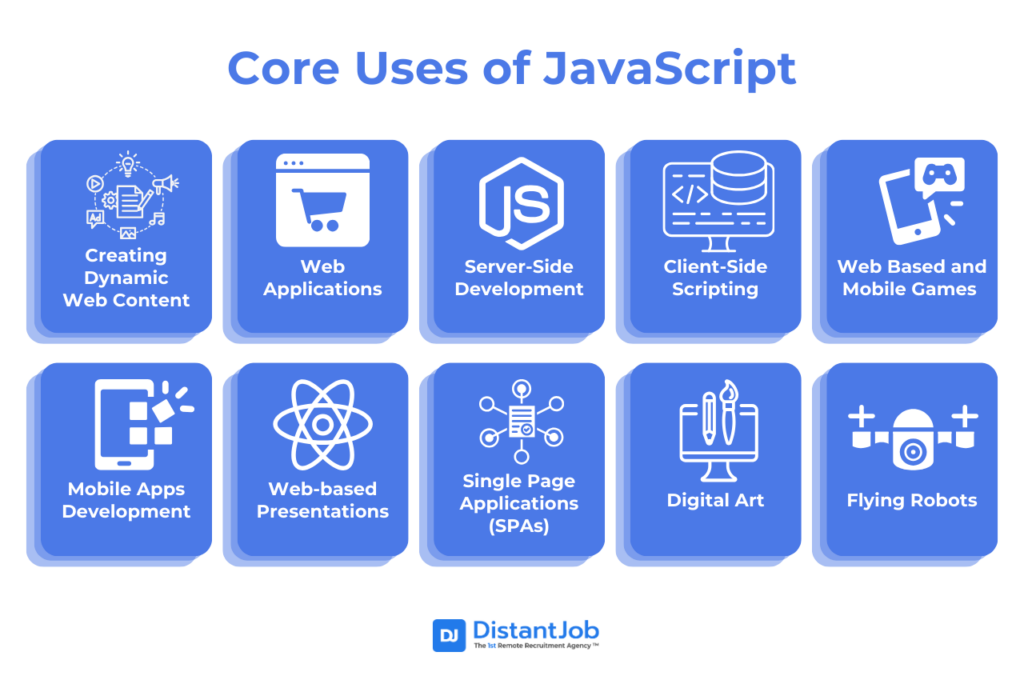JavaScript (JS) is a cross-platform, object-oriented programming language that developers use on websites, particularly for scripting web pages.
Since JavaScript enables dynamic content updates, interactive maps, and multimedia controls, websites are interactive and engaging. Without JavaScript alongside HTML and CSS, 90% of Internet web pages would remain dull and static.
Statistics also reveal that JavaScript is the most used among the popular programming languages on the Web, with 57.8 percent of software developers using it as of 2023.
However, JavaScript’s use extends beyond adding interactive elements to engage users on web pages. So, why use JavaScript, and why do I need JavaScript applications?
Let’s find out!
Core Uses of JavaScript

JavaScript is primarily a scripting language that developers rely on when creating and adding dynamic content for websites to make them user-friendly and interactive. JavaScript’s versatility has transformed it into a powerful programming language, no longer restricted to its primary function of making websites interactive.Here is a rundown of the uses of JavaScript and areas where you can apply it:
1. Creating Dynamic Web Content
The most popular and arguably the primary application of JavaScript is Web development, with a specific function of creating dynamic and interactive web content. After developing a website, developers can use JavaScript to add the following dynamic elements to the web pages:
- Animations
- Image sliders
- Form validation
- Real-time updates
The Document Object Model (DOM) allows JavaScript to change a web page’s style and structure in real time based on user interactions, providing a more enhanced user experience with seamless and responsive interactions.
2. Web Applications
JavaScript has many frameworks that allow developers to create robust web applications for faster publications. Most Web Applications, such as those for online shopping rely on technologies like HTML, CSS, alongside JavaScript data processing and user interaction.
Aside from front-end app development, JavaScript has frameworks developers can use for the back-end. For example, Node.js is a popular back-end framework that allows developers to develop a web application entirely using JavaScript as the only programming language.
3. Server-Side Development
JavaScript applications also extend into server-side development, where developers can use the Node.js framework to build scalable server applications.
The idea of a server-side JavaScript application is that Node.js developers can write code once, so the same code runs on both the client and server. Using the same scripting language on the client and server-side might allow for better code utilization.
JavaScript application for server-side development also solves the problem of having to use two different languages in front-end and back-end.
4. Client-Side Scripting
Client-side scripting is a process that validates user input on the browser before this data is submitted to the server. As a client-side script, JavaScript shortens the amount of time required to create a server connection and in turn speeds up the entire program execution process.
Additionally, JavaScript statements that react to events like mouse clicks, drags, or form input without a connection can be embedded within an HTML document. Users can take use of interactive features like real-time search results without having to refresh the website.
5. Web-based and Mobile Games
The most impressive games on the market today have unique game engines that are primarily based on C, C++, or C#. You’ll hardly hear the mention of JS in complex gaming projects. However, as web browsers become more powerful, some graphics-heavy games like FIFA and other applications have become easier to develop using JavaScript.
JavaScript has built-in functions and libraries that allow for the development of web-based and mobile games. Thanks to HTML5, web-based games are designed to run directly in your browser without additional plugins like Flash. You can also combine JavaScript and HTML5 to create games with rich 2D and 3D graphics.
6. Mobile Apps Development
JavaScript frameworks simplify cross-functional mobile app development for Android, IOS, and Windows operating systems. The frameworks are highly optimized for mobile app development, allowing for less load time and improved app speeds.
One crucial advantage of JS frameworks is that developers can use them for both back-end and front-end mobile application development. For example, JavaScript’s front-end frameworks, such as React Native, allow developers to build mobile apps using JS and native components.
React Native is considered an ideal JavaScript framework for developers working on a web application with the hope of developing a native mobile version. Other JS frameworks used in mobile app development include:
- Ionic
- NativeScript
- Meteor
- Framework7
7. Web-based Presentations
JavaScript has built-in functionalities and libraries that canmake web-based presentations more interactive. If you have a web browser, you can use React.js and BespokeJS frameworks to create interactive presentations for free using HTML designs and CSS stylings.
RevealJs is an open-source HTML presentation framework that allows you to create interactive, deployed presentations with transition styles, themes, and slide backgrounds in CSS color formats.
BespokeJs, on the other hand, provides more interactive and fun features like animated bullet lists and Syntax highlighting to highlight main points and simplify complex information.
8. Single Page Applications (SPAs)
Using JavaScript libraries like ReatJs, AngularJs, PolymerJs, and VueJS, you can create single-page applications (SPAs) for a seamless and responsive browsing experience. SPAs load an HTML page and dynamically rewrite the current web page content using JavaScript.
This differs from the default mechanism, requiring a web browser to load entirely new pages. The JS frameworks like React or Angular handle the client side of these applications. Using JavaScript in SPAs ensures fewer server resources, easy debugging, and an overall responsive user experience without full page reloads.
9. Digital Art
JavaScript has a feature of the canvas element that you can use to create drawings and art on web pages. p5.js is a free and open-source JavaScript library dedicated to creative coding, where artists and designers can create scripts that generate art. If you’re looking to combine programming and art, p5.js makes it easy to create 3D graphics on the web and interactive visualizations for your next digital art project.
10. Flying Robots
JavaScript’s Node.js ecosystem extends its application into robotics, creative maker projects, and IoT devices. Robotic engineers who want to create real-time systems can now use Node.js to build server-side applications that facilitate seamless integration between web apps and robotic hardware.
All that’s required is Node.js installation and the ar-drone module. You can then fly and control your robot drone from an app on your computer. With a simple code execution, you’ll see your drone take off, move around, and carefully land again.
Why is JavaScript Popular?
Almost all computing devices used today, whether on Windows, Android, Linux, macOS, or iOS operating systems, rely on the popular JavaScript frameworks.
As a client-side programming language, JavaScript’s popularity has soared, with its universal adoption for web development reaching almost 99% of all websites.
According to StackOverflow’s users, JavaScript is also the most popular language for professional and hobby use due to:
- You can use it both in the front-end and back-end of web development
- JavaScript is easy to master, starting from beginners to intermediate and even advanced developers
- JavaScript is highly versatile compared to other programming languages, as it can be on all devices
- It has a vast ecosystem and a wide range of frameworks to help build complex applications
- JavaScript promotes interactivity, enabling developers to add interactive elements to website content
- Many browsers support JavaScript, and you can easily view JavaScript-based web pages and applications across various platforms and devices.
- For JavaScript beginners, there’s a large and active JS community that contributes to the language’s growth and provides valuable resources for learners worldwide.
Conclusion
JavaScript is a top programming language for web development. Developers can use it to script web pages. While its primary use is to make web pages more dynamic, JavaScript’s versatility makes it a universal language you can rely on for almost any programming project.
But before you adopt JavaScript, you must hire the best developers adept at JavaScript frameworks to ensure its successful implementation.
DistantJob is one of the best IT remote recruitment agencies that provides you access to pre-vetted and expert JS developers ready to take on your next javascript project. We have a rigorous vetting process for general and framework specialists such as Angular, Vue.js, Node.js, and React developers, who are sure to fulfill your specific needs.





